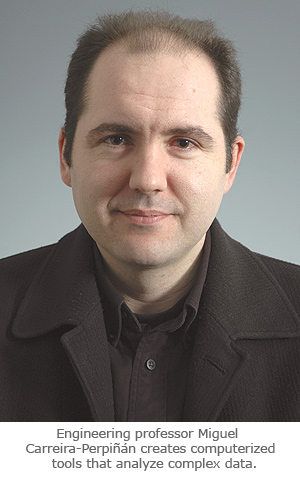

Engineeringprofessor
Miguel Carreira-Perpiñánconcedes his work is a little tricky to explain to someone who isn’t all about mathematics and computers. He works to build models that can automatically extract useful information from extremely complex data.
“Machine learning is at the intersection of
computer science, statistics, physics, electrical engineering, control engineering and mathematics,” said the new professor, who arrived at UC Merced in July 2007 after several years as a professor at Oregon Health and Science University. “You can come to it from any of those fields with strong foundations in
mathematics.”
It’s when he starts talking about the problems that can be solved using his tools that people start to see why his work is so fascinating.
For example, he spends part of his time working on a National Science Foundation CAREER Award-supported project constructing algorithms to break through one of the oldest and biggest problems in computer speech recognition, that of reconstructing the vocal tract positioning that produces a particular sound. A given sound may be produced in a number of ways by the vocal cords, tongue and teeth. Those multiple solutions create a nonlinear, multivalued problem that is well suited for a machine learning approach.
Carreira-Perpiñán’s models can also find accurate patterns in data from motion-capture equipment tracking a sample of walking or running humans. That means the program can then predict how a person outside of the original sample will move when walking or running.
An early project of his involved biometric recognition - specifically, recognizing individuals based on images of their ears.
“It turns out that human ears differ in detail, much like a fingerprint,” he said.
Carreira-Perpiñán’s knowledge can be adapted to additional fields, as well. Naturally, other professors at UC Merced are pleased to have such a versatile toolmaker as a colleague. He’s now working on collaborations with fellow UC Merced professors in computer graphics, robotics and even sensor networks.
“I wouldn’t say I work on specific problems,” he said, “But when I see an area where an application is needed, it inspires the construction of a model to solve a problem.”






